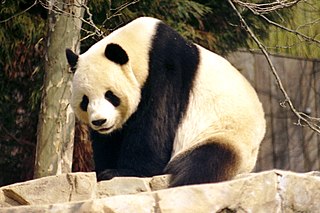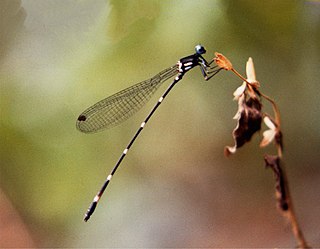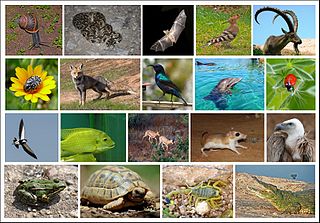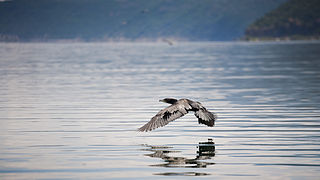Related Research Articles
On 29 January 2010, the IUCN Red List of Threatened Species identified 5220 endangered species, subspecies and varieties, stocks and sub-populations.

Animals are multicellular eukaryotic organisms in the biological kingdom Animalia. With few exceptions, animals consume organic material, breathe oxygen, are able to move, reproduce sexually, and grow from a hollow sphere of cells, the blastula, during embryonic development. Over 1.5 million living animal species have been described—of which around 1 million are insects—but it has been estimated there are over 7 million in total. Animals range in size from 8.5 millionths of a metre to 33.6 metres (110 ft) long and have complex interactions with each other and their environments, forming intricate food webs. The study of animals is called zoology.
Version 2014.2 of the IUCN Red List of Threatened Species identified 4574 Critically Endangered species, subspecies and varieties, stocks and subpopulations.
On 30 January 2010, the IUCN Red List of Threatened Species identified 9694 Vulnerable species, subspecies and varieties, stocks and sub-populations.
Biodiversity in Israel and Palestine is about the fauna and flora in the geographical region of Israel and of the Palestinian National Authority. This geographical area within the historical region of Palestine extends from the Jordan River and Wadi Araba in the east, to the Mediterranean Sea and the Sinai desert in the west, to Lebanon in the north, and to the gulf of Aqaba, or Eilat in the south.
A near-threatened species is a species which has been categorized as "Near Threatened" (NT) by the International Union for Conservation of Nature (IUCN) as that may be vulnerable to endangerment in the near future, but it does not currently qualify for the threatened status.
A data deficient (DD) species is one which has been categorized by the International Union for Conservation of Nature (IUCN) as offering insufficient information for a proper assessment of conservation status to be made. This does not necessarily indicate that the species has not been extensively studied, but it usually indicates that little or no information is available on the abundance and distribution of the species. It can also indicate uncertainty about the taxonomic classification of an organism; for example, the IUCN classifies the orca as "data deficient" because of the likelihood that two or more types of the whale are separate species.

Threatened arthropods are defined here as any of a number of species within the phylum Arthropoda, whose extinction is likely in the foreseeable future. Estimating the number of threatened arthropod species is extremely difficult, primarily because a vast number of the species themselves are not yet named or described. Furthermore, according to Deyrup and Eisner, "The rate of destruction and degradation of natural habitats is currently so great that there are not nearly enough biologists to even catalog the arthropod species that are suddenly on the edge of extinction." In any case, independent estimates indicate that there are millions of undocumented arthropods on Earth.

India is one of the most biodiverse regions and is home to a large variety of wildlife. It is one of the 17 megadiverse countries and includes three of the world's 36 biodiversity hotspots – the Western Ghats, the Eastern Himalayas, and the Indo-Burma hotspot.
The following outline is provided as an overview of and topical guide to zoology:

The wildlife of Israel includes the flora and fauna of Israel, which is extremely diverse due to the country's location between the temperate and the tropical zones, bordering the Mediterranean Sea in the west and the desert in the east. Species such as the Syrian brown bear and the Arabian ostrich have become extinct in Israel because of their loss of habitat. As of May 2007, 190 nature reserves have been established in Israel.

Pakistan's native fauna reflect its varied climatic zones. The northern Pakistan, which includes Khyber Pakhtunkhwa and Gilgit Baltistan, has portions of two biodiversity hotspots, Mountains of Central Asia and Himalayas.

Worms are many different distantly related bilateral animals that typically have a long cylindrical tube-like body, no limbs, and usually no eyes.

A vulnerable species is a species which has been categorized by the International Union for Conservation of Nature as being threatened with extinction unless the circumstances that are threatening its survival and reproduction improve.
On 12 March 2010, the IUCN Red List of Threatened Species identified 3829 near threatened species, subspecies and varieties, stocks and sub-populations.

The wildlife of Finland is affected by prevailing environmental conditions. The phytogeography of Finland is shared between the Arctic, central European, and northern European provinces of the Circumboreal Region within the Boreal Kingdom. The territory of Finland can be subdivided into three ecoregions: the Scandinavian and Russian taiga, Sarmatic mixed forests, and Scandinavian montane birch forest and grasslands. Taiga covers most of Finland from northern regions of southern provinces to the north of Lapland. On the southwestern coast, south of the Helsinki-Rauma line, forests are mixed as is more typical in the Baltic region. In the extreme north of Finland, near the tree line and Arctic Ocean, montane birch forests are common.
As of July 2021, the IUCN lists 14,033 animal species and 6,635 plant species as least concern. No least concern assessments have been made for taxa of other kingdoms.

Endangered species, as classified by the International Union for Conservation of Nature (IUCN), are species which have been categorized as very likely to become extinct in their known native ranges in the near future. On the IUCN Red List, endangered is the second-most severe conservation status for wild populations in the IUCN's schema after critically endangered. In 2012, the IUCN Red List featured 3,079 animal and 2,655 plant species as endangered worldwide. The figures for 1998 were 1,102 and 1,197 respectively.

Over 22,500 species of wildlife have been recorded in North Macedonia. Over 10,000 of these are insects, which include 3,000 beetle species and large numbers of Lepidoptera, flies, and Hymenoptera. Aside from insects, other large arthropod groups include Chelicerata and crustaceans. Among vertebrates, more than 300 species of birds recorded, although not all nest in the country. There are over 80 species of both fish and mammals, 32 reptiles, and 14 amphibians.

The JapaneseRed List is the Japanese domestic counterpart to the IUCN Red List of Threatened Species. The national Red List is compiled and maintained by the Ministry of the Environment, alongside a separate Red List for marine organisms. Similarly drawing on the relevant scientific authorities, NGOs, and local governments, the Ministry of the Environment also prepares and publishes a Red Data Book that provides further information on species and habitats.
References
- IUCN 2009. IUCN Red List of Threatened Species, v2009.2. Source of the above list: online IUCN Red List. Retrieved d.d. 29 January 2010.
